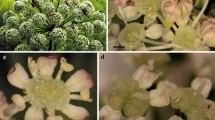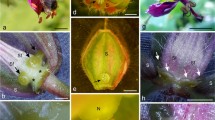Summary
In common milkweed (Asclepias syriaca), flower nectar volumes, concentration and sugar production varied according to the age of the sampled blossoms. In individual blossoms, nectar production peaked daily at 0800 hr. Peak production during the life of the flower occurred on the second day of flowering, 50 h after anthesis, and nectar production ceased after 120 h. The amount and quality of nectar were affected by microclimatic conditions and varied between clones. However, the same secretory patterns were found in all flowers studied. This age dependent nectar secretion combined with the sequential mode of flowering found on a single stem, results in substantial reward for extended periods to nectar feeders.
Similar content being viewed by others
References
Beutler R (1953) Nectar. Bee World 34:106–116, 123–136, 156–162
Beutler R, Schöntag A (1940) Über die Nektarabscheidung einiger Nutzpflanzen. Z. vergl. Physiol. 28:254–285
Browne CA, Zerban FW (1941) Physical and chemical methods of sugar analysis. 3rd ed. John Wiley and Sons Inc. New York
Collison C (1973) Nectar secretion and how it affects the activity of honey bees in the pollination of hybrid picling cucumbers, Cucumis sativa L., M.S. thesis, Michigan State Univ East Lansing
Corbet SA, Willmer PG, Beament JWL, Unwin DM, Prŷs-Jones OE (1979) Post-secretory determinants of sugar concentration in nectar. Plant Cell Envir 2:293–308
Ewert R (1936) Honigen and Samenansatz des Rotklees 1936. Deutsch Imkerführer 10:476–480
Faegri K, van der Pijl L (1979) The principles of pollination ecology. 3rd ed. Pergamon Press NY
Free JB (1970) Insect pollination of crops. Academic Press, London
Galil J, Zeroni M (1965) Nectar system of Asclepias curassavica. Botan Gaz 126:144–148
Huber H (1956) Die Abhängigkeit der Nektarsekretion von Temperatur, Luft- und Bodenfeuchtigkeit. Planta 48:47–98
Jaycox ER (1976) Beekeeping in the mid-west. Univ Illinois College Agri Coop Ext Serv Circ 1125
Johnson LH (1946) Nectar secretion in clover. Effect of soil and climate on honey production. New Zealand Agri 73:111–112
Loper GM, Waller GD, Berdel RL (1976) Effect of flower age on sucrose content in nectar of Citrus. Hort Sci 11:416–417
Meuse BJD (1961) The story of pollination. Ronald Press Co NY
Oertel E (1944) Variation in the sugar concentration of some southern nectars. J Econ Ent 3:525–527
Park PW (1929) The influence of humidity upon sugar concentration in the nectar of various plants. J Econ Ent 22:534–544
Pellett FC (1976) American honey plants. Dadant and Sons, Hamilton, Illinois
Percival M (1965) Floral biology. Pergamon Press NY
Raw GR (1953) The effect on nectar secretion of removing nectar from flowers. Bee World 34:32–35
Robinson IA, Oertel E (1975) Sources of nectar and pollen. In: Dadant and Sons (eds) The hive and the honey bee, Dadant and Sons, Hamilton, Illinois p 283–302
Shuel RW (1975) The production of nectar. In: Dadant and Sons (eds) The hive and the honey bee, Dadant and Sons, Hamilton, Illinois p 265–282
Shuel RW, Shivas JA (1953) The influence of soil physical condition during the flowering period on nectar production in snapdragon. Plant Physiol 28:645–651
Southwick EE (1982) “Lucky Hit” nectar rewards and energetics of plant and pollinators. Comp Physiol Ecol 7:49–53
Southwick EE, Loper GM, Sadwick SE (1981) Nectar production, composition, energetics and pollinator attractiveness in spring flowers of western New York. Amer J Bot 68:994–1002
Southwick EE, Southwick AK (1980) Energetics of feeding on tree sap by ruby-throated hummingbirds in Michigan. Amer Midland Nat 104:328–333
Stephenson AG, Thomas WW (1977) Diurnal and noctural pollination of Catalpa speciosa (Bignoiaceae). Syst Bot 2:191–198
Willson ME, Bertin RI (1979) Flower-visitors, nectar production and inflorescence size of Asclepias syriaca. Can J Bot 57:1380–1388
Wykes GR (1953) The sugar content of nectars. Biochem J 53:294–296
Author information
Authors and Affiliations
Rights and permissions
About this article
Cite this article
Southwick, A.K., Southwick, E.E. Aging effect on nectar production in two clones of Asclepias syriaca . Oecologia 56, 121–125 (1983). https://doi.org/10.1007/BF00378227
Received:
Issue Date:
DOI: https://doi.org/10.1007/BF00378227




